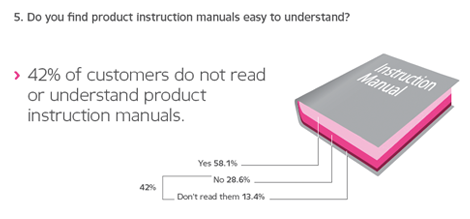We’re rather used to getting slightly random sounding press releases through and often look at them and wonder “Why was this sent to us“. That said, the occasional thing comes through that while it might initially get that “Huh?” reaction, it starts to sink in.
Today I got one such email pop into my inbox from the folks at Kyp (www.kyp.com), a specialist in consumer engagement (or why people buy or don’t buy stuff), on consumer electronics shopping behaviour. While it was full of interesting details such as the fact that 56% of consumers still prefer to buy in-store, but carry out research online prior to large purchases, one result leapt out at me. The graphic below explains it nicely:

To my mind that’s an interesting statistic and one that seems intuitive for someone that’s put their fair share of Billy Bookcases from IKEA together. Instruction manuals are a pain in the arse. They take an age to create and it turns out that customers aren’t using them. WHile this isn’t going to be the case in industrial circles, where an installation or service manual is key, chances are that many users fo that information are frustrated.
So what does that have to do with product development? The answer is two fold. Firstly, is there anything that can be done with your products to remove the reliance of manuals in the first place. Can labelling, symbology integrated into the tooling or simply better designed products assist? Maybe. But you’ll still have to generate a manual of some type. Can we use better illustrations to convey the message? can we use visuals based on 3D data to present a clearer picture of what needs to be done? and of course, can we perhaps use 3D instructions, either in video or real-time format to make things more clear? Maybe. It’s just a thought – after all, manuals and instructions cost money and it would be an idea to ensure that the money invested is money well spent.
If you want to have a look at the rest of the report, it’s here (direct PDF link)






